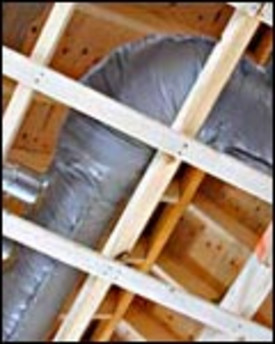 |
|
|
Properly insulating the ducts that move heated and cooled air around your home can save on energy bills for the life of your home.
|
Once the ducts have been installed, and the trunks and runs established, it’s time to finish off the heating system by insulating the ducts. The degree to which you insulate your ducts depends on local building codes for energy efficiency, and whether the ducts are in conditioned or non-conditioned areas. If a duct runs through an unheated crawl space, an unheated basement, or garage, it must typically be insulated to R-4 or greater. If ducts are long or poorly insulated, they often result in cool blows, or gusts of air that have lost the desired temperature. In such a case, running the heat can actually cool a room rather than heat it. The same can be said for cool conditioned air, which must maintain its temperature or fail to cool the room at the other end.
Sealing and Insulating the Ducts
The first step toward fully insulated ducts is to seal all of the points in the duct run. This is done with a mastic that is brushed on then left to dry for at least 24 hours. The mastic seals the joints and protects against air loss and drop in velocity. How quickly the air moves through the ducts determines how well it will hold its temperature. Well-sealed joints allow the ducts to carry air at maximum capacity. Mastic is used because it will not degrade or shrink away from the joint. Duct tape should not be used for this purpose, since the tape degrades and decomposes, leaving the joint leaky and unprotected.
Once the ducts have been sealed, an insulating jacket is wrapped around the ducts and plenum. Like wall insulation, duct insulation is typically made of fiberglass. Insulators may use rigid insulation or faced fiberglass. The fiberglass surface faces in toward the duct, while the foil face protects the outside of the wrap, preventing conductive heat loss and protecting the fiberglass within. The insulation is applied in sheets that are cut to fit and seamed, usually along the sides. While some installers use foil tape for this purpose, most insist on attaching the pieces to one another with a staple gun. Staples are less likely to degrade or lose grip over time.
Alternatives
 |
|
|
Reflectix foil-faced insulation is resistant to moisture, and is relatively easy to install. Image courtesy of Reflectix Inc.
|
Reflectix is a radiant barrier wrap designed to insulate against heat loss. Unlike traditional fiberglass insulation, Reflectix is made up of foil faces on the outside that hold bubble pack between layers of polyethylene for stability. Reflectix is designed to reflect 97 percent of radiant heat, keeping ducts cooler in the summer and warmer in the winter. While fiberglass insulation comes in two-inch-thick applications, Reflectix packs its seven layers in just 5/16-inch. As Jack Alexander, president of Atlanta Supply Co., of Atlanta, Georgia explains, Reflectix carries an R-5.6 value, a figure that would take two inches of insulated fiberglass to achieve.
One of the drawbacks of fiberglass is its vulnerability to moisture. When pipes or ducts experience condensation, that moisture transmits to the fiberglass, forcing it to pack and lose its insulative value. Reflectix is fully foil faced and poly filled. It is installed with spacers every six to eight inches so that it sits away from the duct itself. This airspace prevents moisture buildup and discourages mold and mildew. There is no fiber to encourage nesting insects, and it cannot be pulled tight like fiberglass wrap. Again, once fiberglass wrap is pulled tight, packing occurs which interferes with the product’s ability to achieve full insulative value. To reach its stated R-value, fiberglass must be carefully installed, and kept dry. Because there are so many variables including the loft of the fiberglass insulation and the moisture, Alexander also believes that fiberglass alternatives are easier to install than traditional duct wraps.
Cost Effective Duct Insulation R-Values*
| If you live in a climate that it… | and your heating system** is a… | insulate to these levels in the…
|
|
| unheated/unconditioned attic | unheated/unconditioned basement/crawlspace | ||
| warm with cooling and minimal heating requirements (i.e., FL & HI, coastal CA; southeast TX; southern LA, AR, MS, AL & GA). | gas/oil or heat pump | R-4 to R-8 | none to R-4 |
| electric resistance | R-4 to R-8 | none to R-4 | |
| mixed with moderate heating and cooling requirements (i.e., VA, WV, KY, MO, NE, OK, OR, WA & ID, southern IN, KS, NM, & AZ; northern LA, AR, MS, AL & GA; inland CA & western NV). | gas/oil or heat pump | R-4 to R-8 | R-2 to R-8 |
| electric resistance | R-4 to R-8 | R-2 to R-8 | |
| cold (i.e., PA, NY, New England, northern Midwest, Great Lakes area, mountainous areas (e.g. CO, WY, UT, etc.)). | gas/oil | R-6 to R-11 | R-2 to R-11 |
| heat pump or electric resistance | R-6 to R-11 | R-2 to R-11 | |
* Adapted from Modera et al, “Impacts of Residential Duct Insulation on HVAC Energy Use and Life Cycle Cost to Consumers,” ASHRAE Transactions (#AT-96-13-4). ** Insulation is also effective at reducing colling bills. These levels assume that you have electric air-conditioning |
|||
Credit: Renovate Your World




























